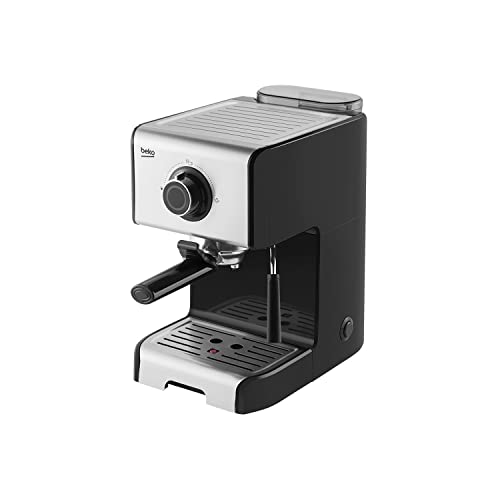You'll Never Guess This Espresso Machine Coffee's Tricks
페이지 정보
작성자 Heather 작성일24-11-26 02:15 조회4회 댓글0건본문
How to Make Espresso Machine Coffee
Espresso machines can produce a delicious cup, but they require more care and setup than a typical coffee maker. It is also necessary to grind and tamp the beans yourself.
The secret to making espresso is pressure. Here's how an espresso machine operates: a heating vessel is used to heat water to a suitable temperature, and then pushes it through the grounds and out the spouts.
Temperature
Espresso is produced by forcing hot water, under pressure, through finely ground coffee espresso machines beans. The temperature of the water is crucial to the final shot. Low temperatures lead to inadequate extraction of essential flavor compounds. High temperatures can cause excessive extraction, which could result in a bitter or burned taste.
The ideal temperature range for espresso is between 195 and 205 degF. This temperature is achieved by using an espresso group head that has been made to maintain the stability of temperature and maintain a constant temperature throughout the brewing cycle. The E61 is the most well-known group head, as it offers a combination of temperature stability, pre-infusion capabilities and lever control.
It is important to consider the temperature when you adjust your espresso machine for different roasts or brew ratios. This will affect the extraction yield and the crema. The ideal temperature will vary on the particular roast and beans but the general rule is that lighter roasts and higher brew ratios require higher temperatures than darker roasts and lower ratios of brew. Additionally, a high thermocouple of good quality is essential in ensuring a consistent temperature.
 Pressure
Pressure
During the brewing process, espresso machine coffee is pressure-pushed through finely ground and tamped grounds. This triggers chemical reactions that extract flavors, oils, and other soluble ingredients. The beverage that is made is usually richer and more flavorful.
The ideal espresso machine with frother machine pressure is nine bars of pressure that's the same as the atmospheric pressure at sea level. The soluble compounds found in the espresso bean are best extracted at this pressure.
Some espresso machines advertise up to 20 bar of pressure. While these machines may reach these levels of pressure however, they may not be able to maintain the same pressure throughout the extraction.
To put it into perspective, one bar of pressure is equivalent to the 32 pounds per square inch, or PSI, of a car tire. This is more than four times the pressure a professional cyclist uses to pump up their bike tires. Any serious home barista must to be able to regulate the pressure of their espresso machine, and also produce consistent espressos.
Water
The water you use in your espresso maker is among the most important elements that make a good cup coffee. The right water can allow your beans to reach their full potential. However, the wrong water could cause issues like clogged pipes, or even damage your expensive espresso machine.
To get the most espresso extraction You should select an untreated natural spring with a high mineral content. This water will enhance the flavor of your espresso without the chalky mineral trace that is found in tap water or bottled waters. This is an excellent alternative to distilled or reverse osmosis filtered water, that can be too pure and cause problems with flavor.
However, you should not use a water filter that removes excessive minerals from your tap water since this can cause flavor and extraction issues. A great option is to buy an instrument for testing water, which will provide you with the water hardness in your area. This can then be used to find the best filtration system to give you the correct water specs for your espresso machine.
Beans
Most coffee aficionados tend to be very involved in the entire process of making espresso. They obsess about a number factors, such as temperature, water pressure and viscosity. If one of the variables is not in order the whole shot could taste bad.
The beans used are the most important thing when it comes to espresso. People often assume that only certain kinds of beans work well for espresso. While some beans are better designed for specific uses however, any roast can be used to make espresso. The difference between espresso beans and regular coffee beans is that retro espresso maker beans are roasted more by tipycally extending past the second crack that gives them more of a dark appearance and makes them more water-soluble.
Medium or dark-roasted beans are best for espresso as they impart the espresso with richness and a boldness. However, it is possible to make excellent espresso using light roast beans, particularly when the beans are ground prior to grinding (for convenience in an espresso machine).
Milk
Espresso and milk are a timeless combination. The combination of espresso and milk is an old-fashioned. Not only does it increase energy levels but it also helps balance the bitterness in the espresso. This is one of the best culinary pairings!
When selecting an espresso maker capable of making latte, or a cappuccino it is important to consider how easy it is to use. A majority of the top espresso machines come with a jug for hot or cold milk as well as steam wand. They also come with a portafilter for pulling the shot. Some models come with an integrated grinder, tamper and frother.
To remove any condensed water the steam wand needs to be purged each day before use (or after each espresso cup). This process takes about 30 seconds and is essential to ensure that your machine is operating smoothly. If you don't purge it, it could result in bitter taste and/or buildup of bacteria that can alter the taste or odor of your beverage. It's easy to perform and should be part of your regular maintenance routine.
Espresso machines can produce a delicious cup, but they require more care and setup than a typical coffee maker. It is also necessary to grind and tamp the beans yourself.
The secret to making espresso is pressure. Here's how an espresso machine operates: a heating vessel is used to heat water to a suitable temperature, and then pushes it through the grounds and out the spouts.
Temperature
Espresso is produced by forcing hot water, under pressure, through finely ground coffee espresso machines beans. The temperature of the water is crucial to the final shot. Low temperatures lead to inadequate extraction of essential flavor compounds. High temperatures can cause excessive extraction, which could result in a bitter or burned taste.
The ideal temperature range for espresso is between 195 and 205 degF. This temperature is achieved by using an espresso group head that has been made to maintain the stability of temperature and maintain a constant temperature throughout the brewing cycle. The E61 is the most well-known group head, as it offers a combination of temperature stability, pre-infusion capabilities and lever control.
It is important to consider the temperature when you adjust your espresso machine for different roasts or brew ratios. This will affect the extraction yield and the crema. The ideal temperature will vary on the particular roast and beans but the general rule is that lighter roasts and higher brew ratios require higher temperatures than darker roasts and lower ratios of brew. Additionally, a high thermocouple of good quality is essential in ensuring a consistent temperature.
 Pressure
PressureDuring the brewing process, espresso machine coffee is pressure-pushed through finely ground and tamped grounds. This triggers chemical reactions that extract flavors, oils, and other soluble ingredients. The beverage that is made is usually richer and more flavorful.
The ideal espresso machine with frother machine pressure is nine bars of pressure that's the same as the atmospheric pressure at sea level. The soluble compounds found in the espresso bean are best extracted at this pressure.
Some espresso machines advertise up to 20 bar of pressure. While these machines may reach these levels of pressure however, they may not be able to maintain the same pressure throughout the extraction.
To put it into perspective, one bar of pressure is equivalent to the 32 pounds per square inch, or PSI, of a car tire. This is more than four times the pressure a professional cyclist uses to pump up their bike tires. Any serious home barista must to be able to regulate the pressure of their espresso machine, and also produce consistent espressos.
Water
The water you use in your espresso maker is among the most important elements that make a good cup coffee. The right water can allow your beans to reach their full potential. However, the wrong water could cause issues like clogged pipes, or even damage your expensive espresso machine.
To get the most espresso extraction You should select an untreated natural spring with a high mineral content. This water will enhance the flavor of your espresso without the chalky mineral trace that is found in tap water or bottled waters. This is an excellent alternative to distilled or reverse osmosis filtered water, that can be too pure and cause problems with flavor.
However, you should not use a water filter that removes excessive minerals from your tap water since this can cause flavor and extraction issues. A great option is to buy an instrument for testing water, which will provide you with the water hardness in your area. This can then be used to find the best filtration system to give you the correct water specs for your espresso machine.
Beans
Most coffee aficionados tend to be very involved in the entire process of making espresso. They obsess about a number factors, such as temperature, water pressure and viscosity. If one of the variables is not in order the whole shot could taste bad.
The beans used are the most important thing when it comes to espresso. People often assume that only certain kinds of beans work well for espresso. While some beans are better designed for specific uses however, any roast can be used to make espresso. The difference between espresso beans and regular coffee beans is that retro espresso maker beans are roasted more by tipycally extending past the second crack that gives them more of a dark appearance and makes them more water-soluble.
Medium or dark-roasted beans are best for espresso as they impart the espresso with richness and a boldness. However, it is possible to make excellent espresso using light roast beans, particularly when the beans are ground prior to grinding (for convenience in an espresso machine).
Milk
Espresso and milk are a timeless combination. The combination of espresso and milk is an old-fashioned. Not only does it increase energy levels but it also helps balance the bitterness in the espresso. This is one of the best culinary pairings!
When selecting an espresso maker capable of making latte, or a cappuccino it is important to consider how easy it is to use. A majority of the top espresso machines come with a jug for hot or cold milk as well as steam wand. They also come with a portafilter for pulling the shot. Some models come with an integrated grinder, tamper and frother.
To remove any condensed water the steam wand needs to be purged each day before use (or after each espresso cup). This process takes about 30 seconds and is essential to ensure that your machine is operating smoothly. If you don't purge it, it could result in bitter taste and/or buildup of bacteria that can alter the taste or odor of your beverage. It's easy to perform and should be part of your regular maintenance routine.
댓글목록
등록된 댓글이 없습니다.





